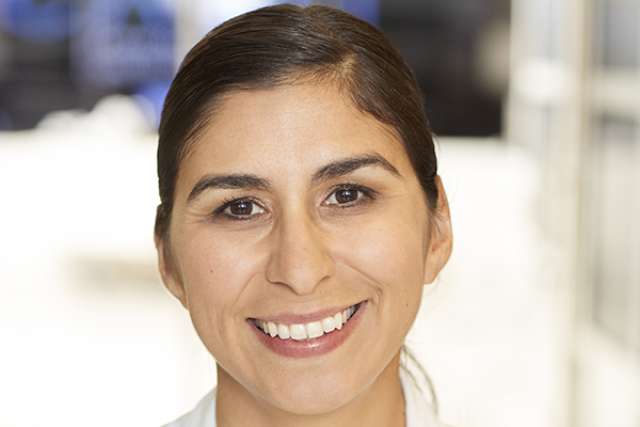Dr. Alejandra Casillas was first struck by the rise of digital health in 2016, when she returned to the United States from a four-year stint working in Europe. Casillas, now an assistant professor of medicine in the division of general internal medicine and health services research at the David Geffen School of Medicine at UCLA, has had a longtime interest in health disparities, with a particular focus on health communications among underserved and limited English proficient communities.
Following her service as chief medical resident at UCSF Medical Center and as a Robert Wood Johnson Clinical Scholar at UCLA, Casillas went to Switzerland, where from 2012 to 2016 she addressed immigrant health disparities in the country's French-speaking region.
When she left the U.S., medical records were still largely maintained with paper and pen, she said. On returning to the states, she was struck by what she called the "digital revolution" with patient records. She was particularly interested in its use by the Los Angeles County Department of Health Services, UCLA's partner in providing safety net health services for the poor and uninsured. She found that those records were completely electronic and the county provided digital access to the system's patients – making life easier for a population that already had too many social, economic, and health burdens.
"In our safety net population at the Los Angeles County Department of Health Services, many patients have to take multiple buses or take a day off work, sometimes for simple things-- like a simple question or refilling a medication," Casillas said. "Access to a patient portal takes all those burdens away and streamlines healthcare."
Casillas saw both its promise as well as the hurdles that so much of the underserved Latino community have to leap to benefit from telemedicine. She thought of her mother, a Spanish speaker who experienced her own difficulties navigating her healthcare provider's patient portal. It was difficult enough that Casillas had to step in to help on several occasions. And her mother didn’t rely on the safety net.
"So when I heard about digital health in the L.A. safety net, one of the biggest and most diverse in the nation, I said to myself 'We need to study this. I anticipate there are challenges. We need to find evidence-based interventions to get patients this type of care,'" Casillas said.
This recognition launched her research into making digital health more accessible to non-English speakers, who have to contend with the language barrier and sometimes their legal status. They often lack the financial means to own a computer and must master the intricacies of the internet – and their patient records -- when they do have access to one.
To get the message across, Casillas has spoken with community groups and health care workers, at conferences such as Google's "Salud con Tech" and more to advocate for more user-friendly solutions and relevant digital health applications for these populations.
Providers at other safety net sites appear to agree with the message, and not just for patients. Casillas recently surveyed leaders and administrators at three large safety net health systems in California, which work closely with caregivers. The results, published in July in the peer-reviewed Journal of Medical Internet Research, found that the providers "recognized the potential for portals to improve information delivery and communication by helping caregivers assist socially and medically complex patients in the safety net" while noting that many caregivers themselves face some of the same barriers, particularly with technical and health literacy and language.
And now, in a new paper published Oct. 23 in the same journal, Casillas lays out steps that can lead toward breaking down these barriers. They are:
- Remove unnecessary patient process barriers in enrolling for the portal. This would entail switching from using a social security number to a patient record number as an identifier when registering or using an online portal.
- Re-design engagement materials with a patient-centered approach, such as producing videos in multiple languages about portal usage that could be played in waiting rooms.
- Partner with electronic health record vendors to focus on user interface and usability from a safety net patient perspective, with an emphasis on improving the mobile app version of the portal.
- Create a flexible, patient-friendly mechanism for proxy access by making it easier for safety net providers to connect with the patient's family and friends, who often also serve as caregivers and confidants for decisions on health.
- Create a virtual home for patient-centered care that includes addressing social determinants, preventive care, and chronic care. For example, safety net providers could set up questionnaires that patients can complete which outline their health goals, such as weight loss, and address other needs such as housing. Armed with this knowledge, providers could send this information directly to the patients.
- Redefine the metrics of portal success by adding online forms that patients can use to monitor chronic conditions, track blood sugar and pressure levels, and integrate platforms for food banks, transportation assistance, and other community-based resources that directly or indirectly affect these patients' health.
Given that these populations face numerous barriers to in-person visits, such as their need to take unpaid time off from work, these enhancements could have a significant impact on their access to care, Casillas noted. And safety net providers may need these innovations now more than ever.
"The arrival of the COVID-19 pandemic, where health systems have had to scale back on physical patient visits and in-person patient education and engagement dramatically, with no established telemedicine workflows in place, is a set-up for worsening health disparities for these patients," Casillas said. "They are already at higher risk of poor disease management outcomes. Recent events have only come to prioritize the integral role of the patient portal for care delivery in the Los Angeles safety net."



